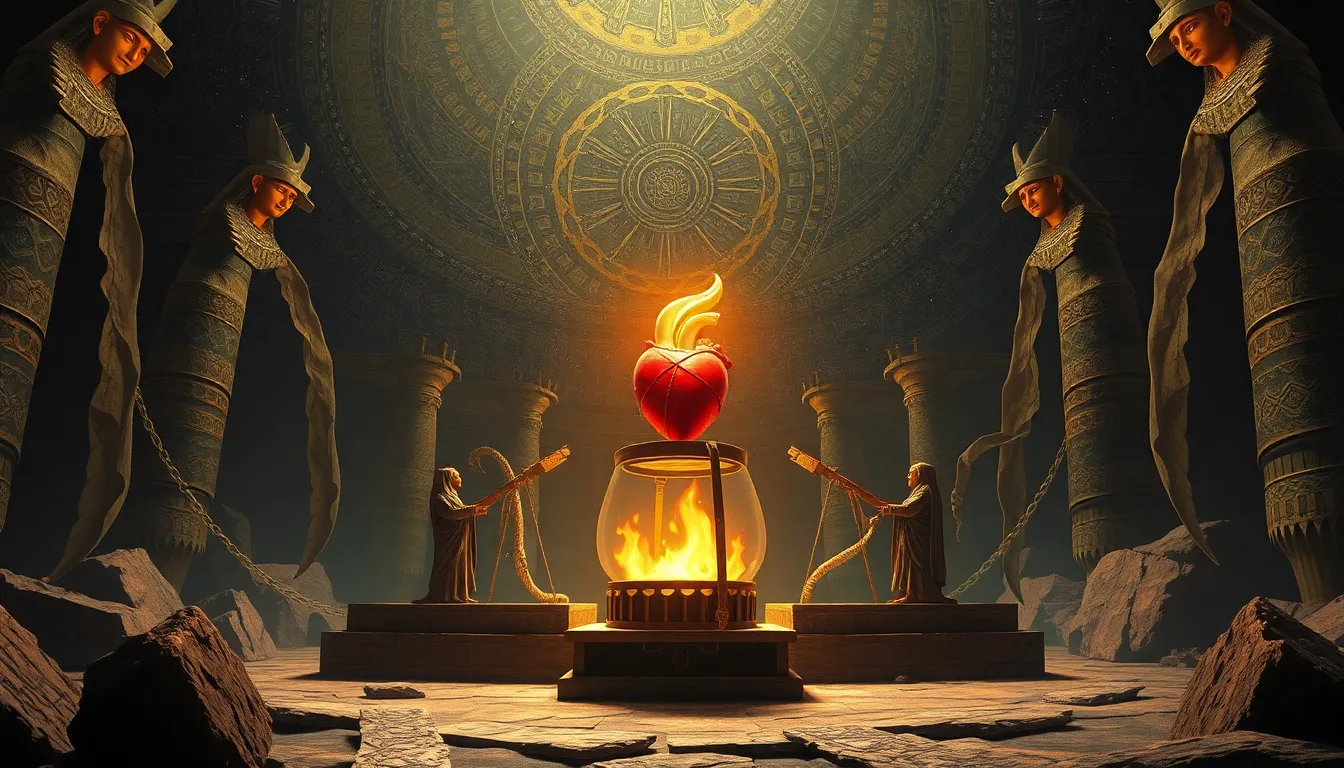The Myth of the Weighing of the Heart: Justice in the Afterlife
I. Introduction
The Weighing of the Heart is one of the most significant myths in ancient Egyptian mythology, representing the ultimate judgment of the dead. In this myth, the soul of the deceased is weighed against the feather of Ma’at, the goddess of truth and justice. This ritual underscores the importance of morality and justice in ancient Egyptian belief systems, reflecting their understanding of the afterlife and the consequences of one’s actions in life.
This article aims to explore the historical context, symbolism, processes, themes, interpretations, and legacy of the Weighing of the Heart myth, highlighting its profound impact on both ancient and contemporary views of justice and morality.
II. Historical Context of the Weighing of the Heart
The Weighing of the Heart has its origins in the ancient Egyptian religion, dating back to the Old Kingdom period. It evolved over centuries, becoming a central feature of the funerary practices and beliefs surrounding the afterlife.
- Origins in Ancient Egyptian Religion: The concept of judgment after death can be traced to early funerary texts and artifacts that suggest a belief in an afterlife where one’s deeds were evaluated.
- Development Through Different Dynasties: As ancient Egyptian civilization progressed, the myth became more codified, especially during the New Kingdom, with the Book of the Dead elaborating on the details of the judgment process.
- Key Texts and Artifacts: The most notable artifact depicting this myth is the Book of the Dead, a collection of spells and instructions meant to guide the deceased through the afterlife, along with tomb paintings and papyri illustrating the judgment scene.
III. The Symbolism of the Heart in Ancient Egypt
In ancient Egyptian culture, the heart was seen as the seat of the soul, intellect, and morality. This contrasts sharply with other cultures that may have emphasized the mind or spirit in their views of the afterlife.
- The Heart as the Seat of the Soul and Morality: Egyptians believed that the heart contained the essence of a person’s being and was the true measure of their character.
- Contrast with Other Cultures’ Views: While many cultures viewed the afterlife as a journey of the spirit, Egyptians uniquely linked the heart to moral judgment.
- The Role of the Heart in Daily Life and Spirituality: The heart was integral to many rituals and was often depicted in artifacts as a symbol of life and moral weight.
IV. The Process of the Weighing Ceremony
The Weighing of the Heart ceremony is vividly described in the Book of the Dead, where it involves several key figures and significant objects.
- Description of the Ceremony: The deceased’s heart is placed on one side of a scale, while the Feather of Ma’at is placed on the other. Anubis, the god of mummification and the afterlife, oversees the weighing.
- Key Figures:
- Anubis: The guide of souls and protector of the dead, Anubis is depicted as a jackal-headed figure.
- Osiris: The god of the afterlife who rules over the dead, Osiris awaits the results of the weighing.
- The Feather of Ma’at: Symbolizing truth and justice, this feather is crucial in determining the fate of the deceased.
- Outcomes of the Weighing: If the heart is lighter than the feather, the deceased is deemed worthy and granted passage to the afterlife. If heavier, it is devoured by Ammit, a demoness, leading to eternal second death.
V. Themes of Justice and Morality
Central to the Weighing of the Heart is the concept of Ma’at, representing cosmic order, truth, and justice. This theme resonates deeply within ancient Egyptian culture.
- The Concept of Ma’at: Ma’at is not just a goddess but a principle that governs the universe and human behavior, emphasizing harmony, balance, and righteousness.
- Personal Accountability: The myth underscores the importance of personal ethics, where individuals are held accountable for their actions during life.
- Comparison with Contemporary Ideas: The themes of justice and accountability in the Weighing of the Heart find parallels in modern legal and moral systems, reflecting a universal quest for fairness and integrity.
VI. Interpretations and Misinterpretations of the Myth
The Weighing of the Heart has been subject to various interpretations and misconceptions over time.
- Common Misconceptions: Some may oversimplify the myth as merely a judgment of good versus evil, neglecting the nuances of moral complexity within it.
- Academic Interpretations: Scholars debate the significance of the myth, examining its implications on ancient Egyptian society and its theological underpinnings.
- Influence of Popular Culture: Modern media often romanticizes or sensationalizes the myth, which can lead to distorted perceptions of its true meaning and significance.
VII. The Legacy of the Weighing of the Heart in Modern Thought
The impact of the Weighing of the Heart extends beyond ancient Egypt, influencing contemporary thought in various ways.
- Impact on Modern Views: The myth encourages reflections on justice, morality, and the consequences of one’s actions, relevant in today’s discussions about ethics.
- Influence on Literature and Art: The imagery and themes of the Weighing of the Heart have inspired countless works of art and literature, illustrating the power of ancient beliefs in modern narratives.
- Continuing Relevance: The myth remains a vital part of discussions around morality and ethics, prompting individuals and societies to evaluate their values and actions.
VIII. Conclusion
In summary, the Weighing of the Heart myth encapsulates the ancient Egyptian understanding of justice and morality, serving as a powerful metaphor for personal accountability and cosmic order. Its enduring significance offers valuable insights into the complexities of human behavior and ethical considerations.
As we reflect on the themes presented in this myth, it becomes clear that ancient beliefs continue to resonate today, encouraging a deeper exploration of our own values and the nature of justice in contemporary society.
We invite readers to delve into these ancient narratives, enriching their understanding of how past beliefs shape modern thought and moral frameworks.




